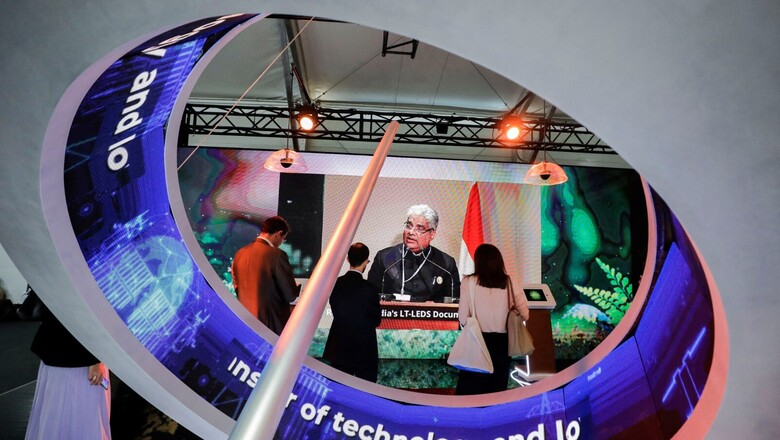
views
Reiterating its commitment to achieve net-zero by 2070, India has unveiled its long-term strategy to bring down emissions over the next five decades at the ongoing UN Climate Summit (COP27) in Egypt’s Sharm-el-Sheikh, while taking into account its emergent and future energy needs and the need to build climate resilience.
The country is now among 57 other nations, along with the US and China, who have laid out their action plans under the Paris Agreement which requires the world to limit global warming to 1.5 degree Celsius.
Highlighting India’s low historical contribution to global warming despite having a share of 17% of the world’s population, the Modi-government’s long-term low carbon strategy (LT-LEDS) rests on the key pillars of ensuring adequate energy access for development, the need to build climate resilience and commitment to pursue low-carbon strategies for development as per the national circumstances.
“Having clear ‘buckets’ for action, as the strategy does, is very important to mobilise bureaucracies and send clear signals for action to the private sector,” said Prof Navroz K Dubash from the Centre for Policy and Research (CPR), stating that the plan is firmly, and appropriately, anchored in considerations of climate equity, and termed it a sound beginning.
Just Transition – Electrification, Biofuels
While fossil fuels will continue to be part of rational use of natural resources to protect energy security, any transitions will be undertaken in a just, smooth, and sustainable manner, India has said. The government has made it clear that just transition cannot be about an early start to de-carbonization in any sector, which would be detrimental to its 2030 Sustainable Development Goals and subsequent development.
The plan rests on increased development of renewable technologies, 2021 National Hydrogen Mission and increased electrification. India strives to be a green hydrogen hub with rapid production and increased electrolyser manufacturing capacity and achieve a three-fold increase in nuclear capacity by 2032.
The low-carbon development of transport sector would be driven by increased use of biofuels, especially ethanol blending in petrol, electric vehicle penetration, and use of green hydrogen fuel. India also aspires to maximise the use of electric vehicles, ethanol blending to reach 20% by 2025, and a strong modal shift to public transport for passenger and freight.
Resource Efficiency & Sustainable Living
With rapid urbanisation underway, India said that it would use smart city initiatives to build future sustainable and climate resilient urban infrastructure. Adaptation and energy and resource efficiency would be mainstreamed in city planning with effective green building codes and solid and liquid waste management.
While the focus would be rational utilization of national resources through recycling, Perform, Achieve and Trade (PAT) scheme, it would be done ensuring that that the overall energy security, energy access and employment is not impacted.
The plan is also supported by its vision of LiFE, Lifestyle for the Environment, that calls for a world-wide paradigm shift from mindless consumption to deliberate utilization. India also shared that it is on track to fulfilling its commitment of 2.5-3 billion tonnes of additional carbon sequestration in forest and tree cover by 2030, and its forest fire incidence is well below global levels.
Where Is Climate Finance?
India has also called out developed countries’ “enormous failure” in delivering financial resources to developing countries for their low-carbon development. The commitment made at COP15 in 2009 to jointly mobilise $100 billion per year by 2020 to help developing countries is yet to materialise, even as estimated costs now required have gone up by trillions of dollars.
At the ongoing COP27, the Indian delegation, led by Union Environment Minister Bhupender Yadav, made it clear that it expects action from rich countries in terms of climate finance and technology transfer, before developing countries are asked to up their ambition.
“Efforts to increase climate ambition from those who have little to give, will only result in inaction,” said Yadav, as he intervened at the Ministerial High-Level Roundtable on pre-2030 ambition on Monday.
While India has emphasised its commitment to global climate action through the recent updating of the Nationally Determined Contributions (NDCs), it urged developed countries to take the lead undertake early net-zero and provide adequate finance and technology in support of India’s plans for low-carbon development.
The environment minister also exhorted the nations to look at pre-2020 responsibility and whether the commitments made before have been fulfilled, before discussing the pre-2030 ambition scenarios. Yadav also emphasized the need for identifying the right sectors for ambition. “To target small farmers for mitigation in the name of ambition would be a serious mistake,” he added.
“India faces the challenge of meeting its growing energy needs even while avoiding lock-in to a high carbon future. The document’s approach of sector-by-sector low-carbon development futures enables India to strike this balance,” said Dr Aman Srivastava, fellow at CPR, on the document.
According to experts, the document has fired the starting gun for a serious transformation of the transport, industrial, and urban sectors.
Long Journey
While submitting its long-term strategy for low carbon development, India highlighted that it would take consistent time, human and financial resources and sustained economic growth to achieve low-carbon development goals. “Calling for ambition from developing countries is not meaningful if the time required from low-carbon development is not recognized. Unfortunately, with every decade, with every new agreement, with every new scientific report, more and more action is demanded from developing countries. If goalposts are changed constantly, it will not yield results but only words and promises,” said the minister.
Read all the Latest India News here


















Comments
0 comment